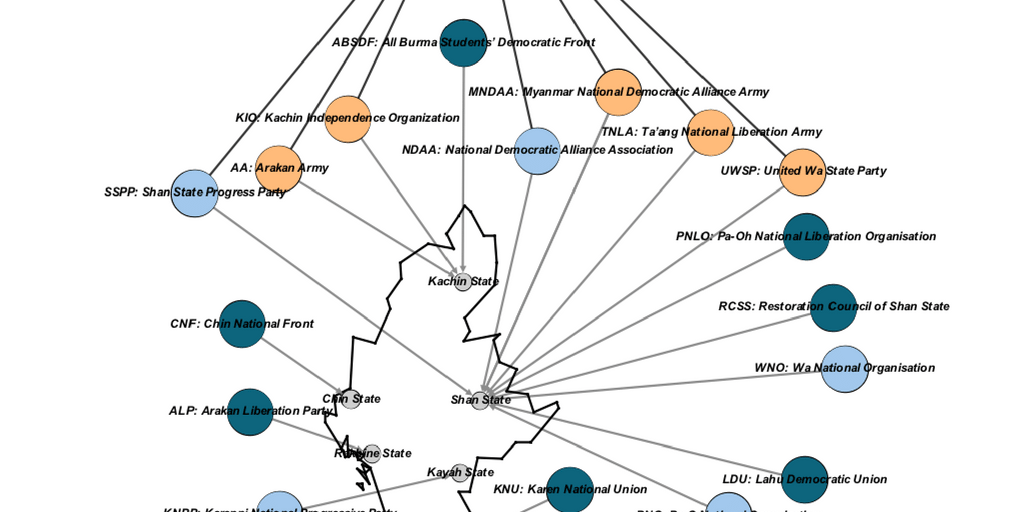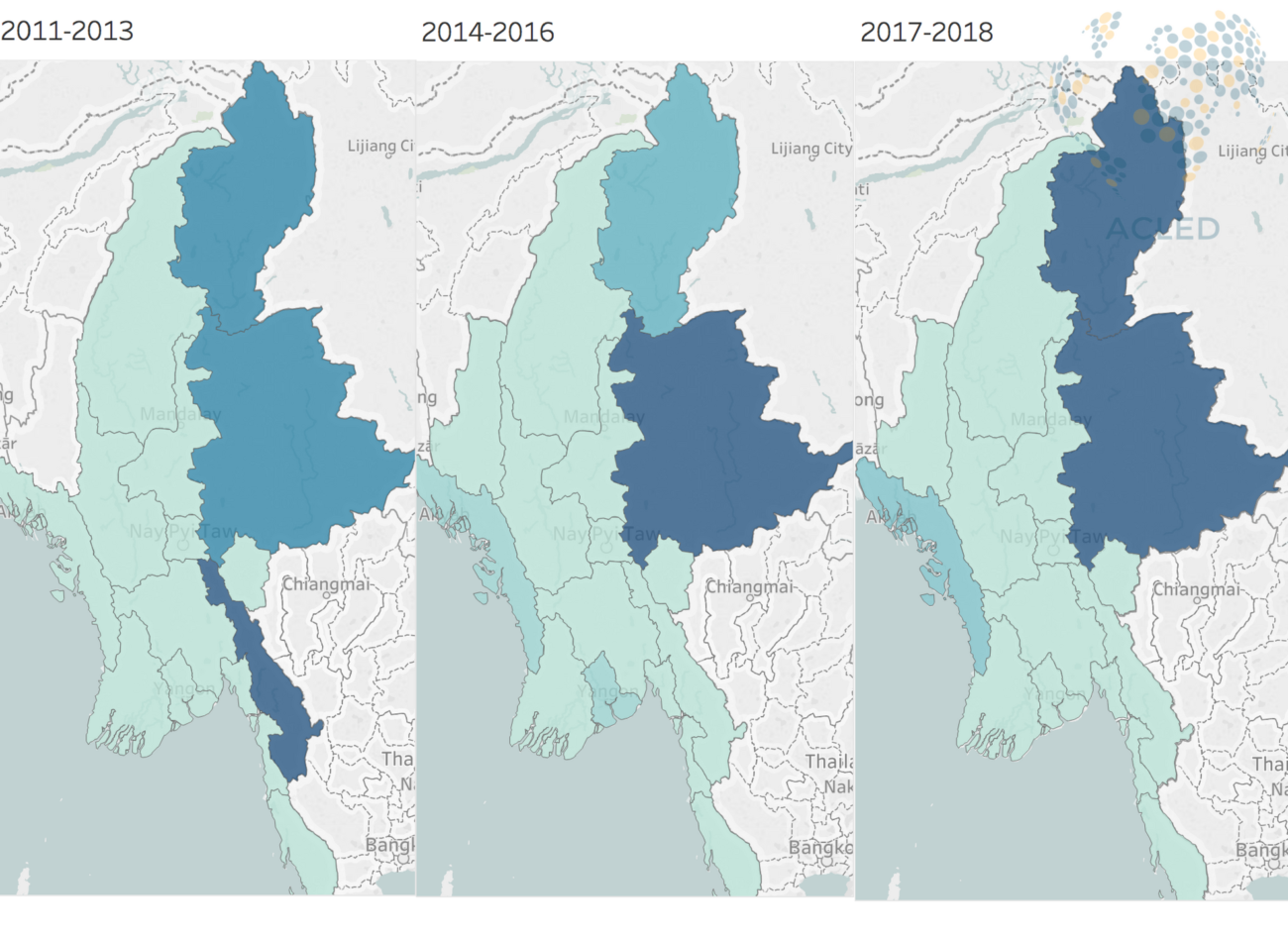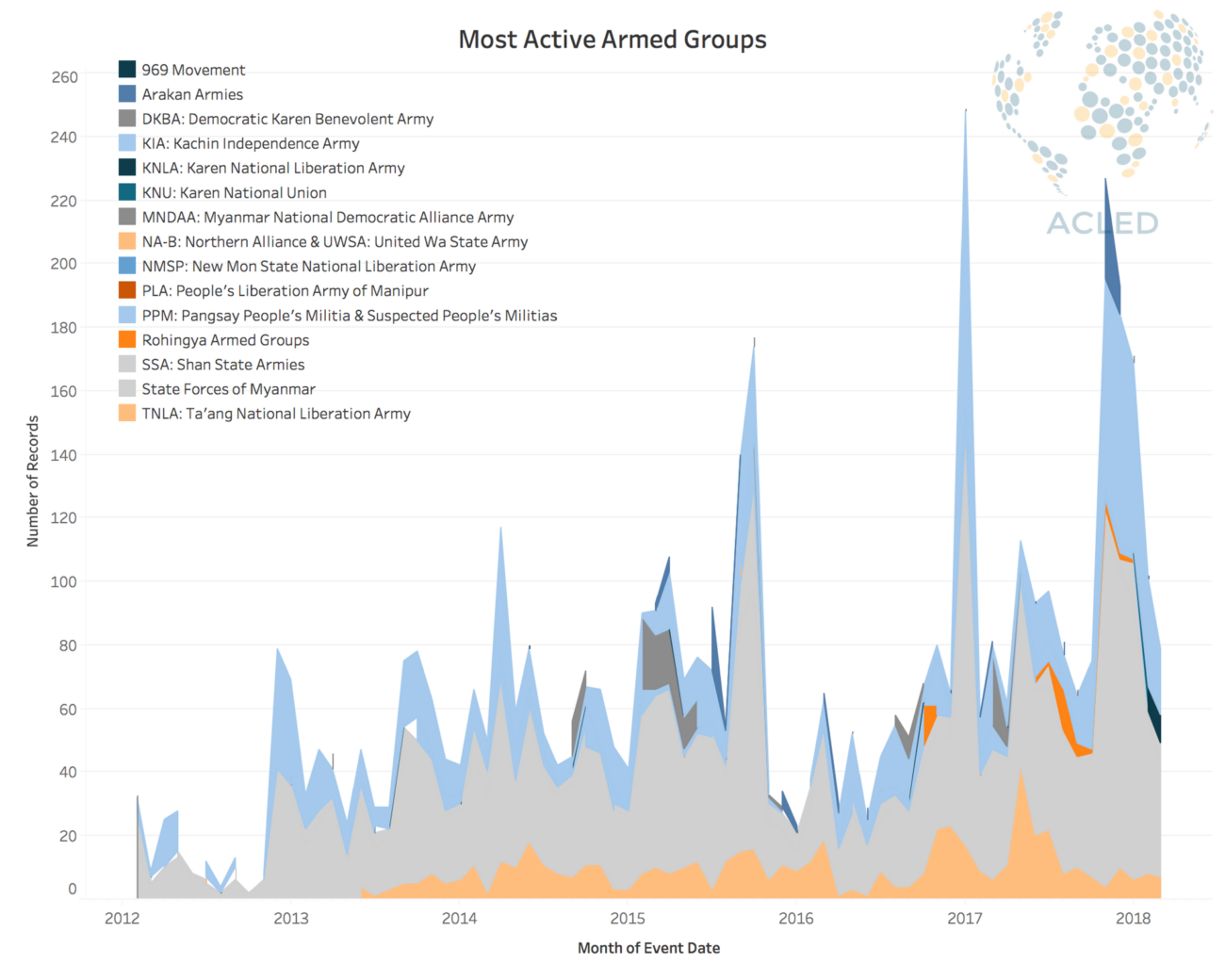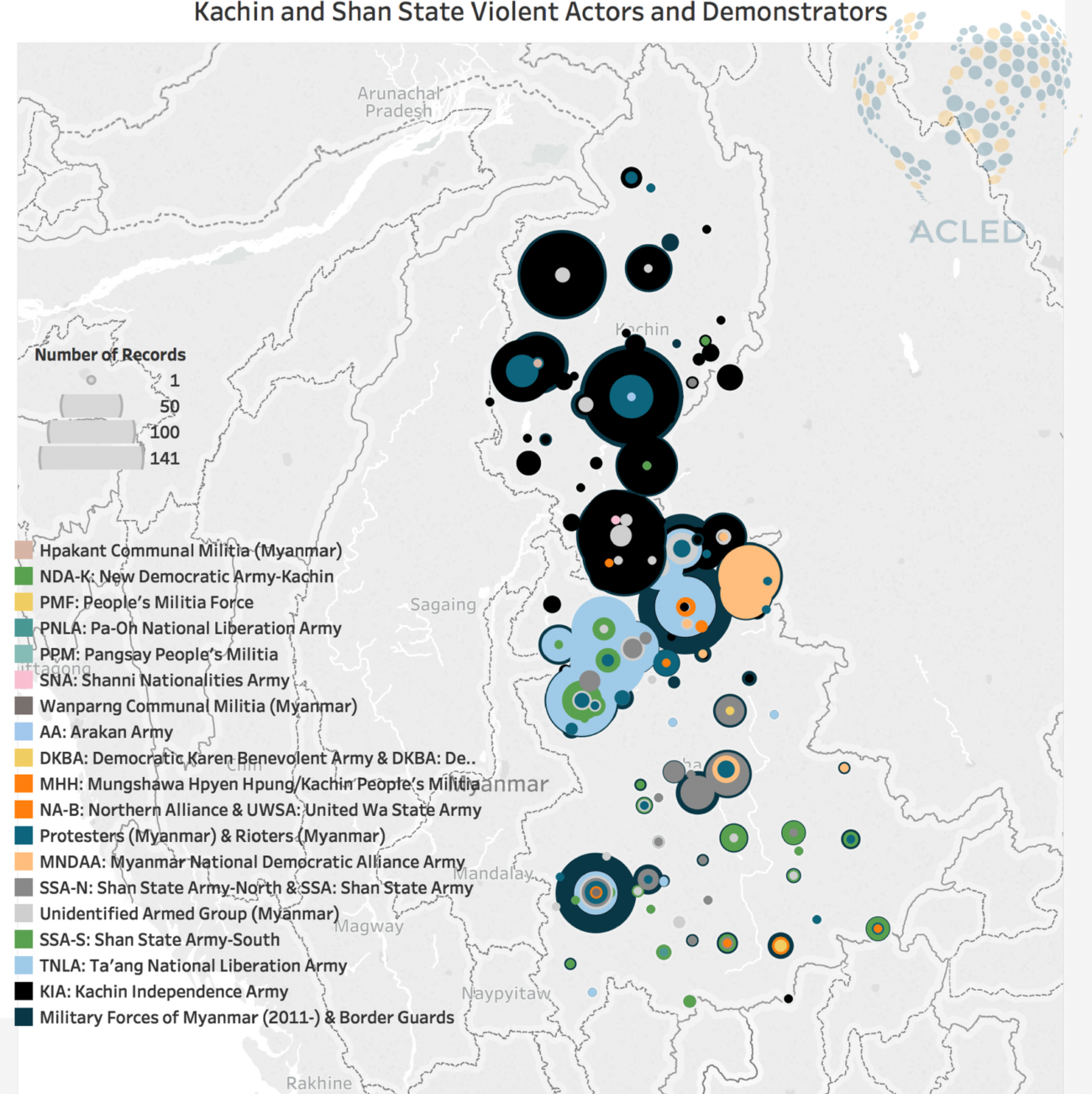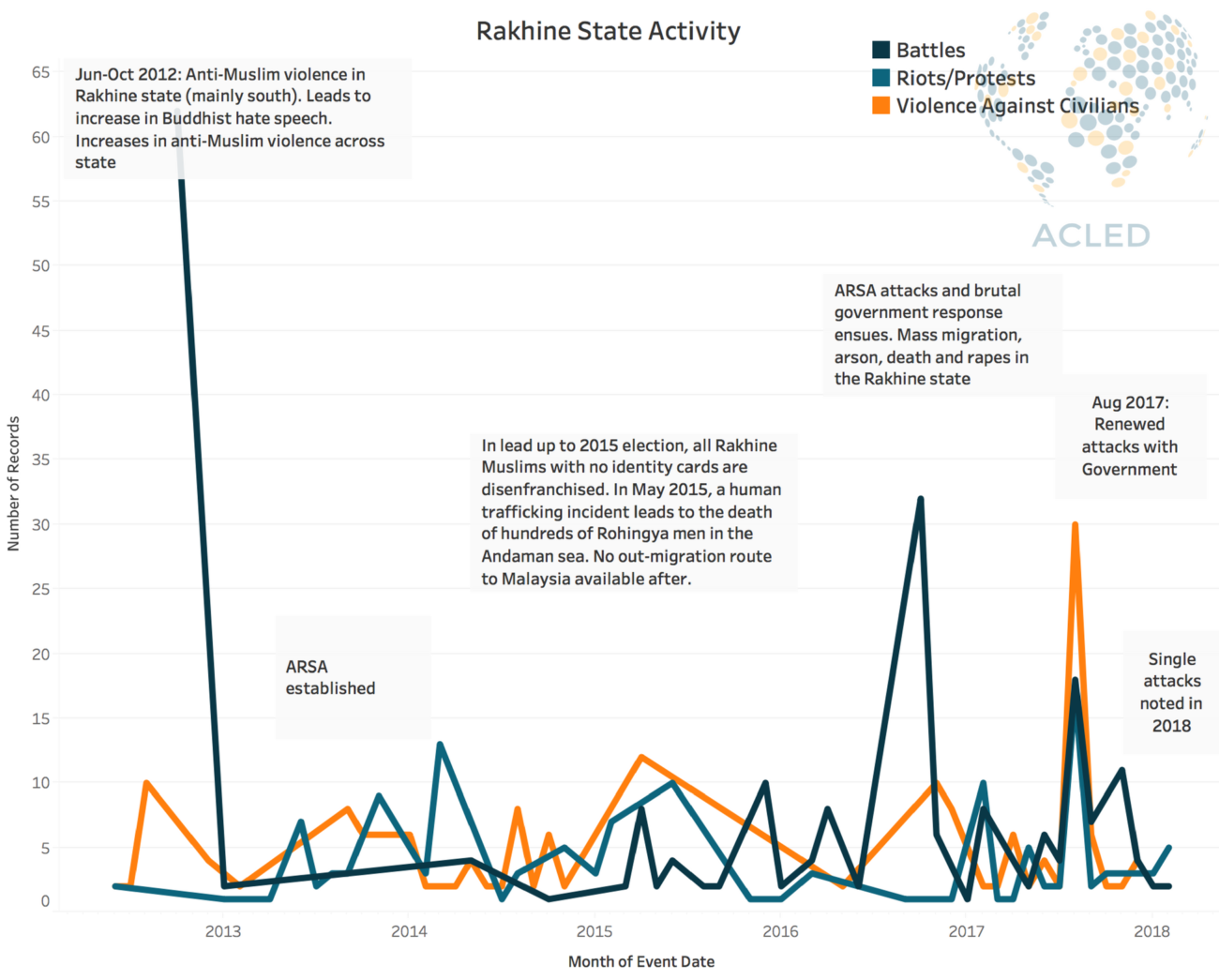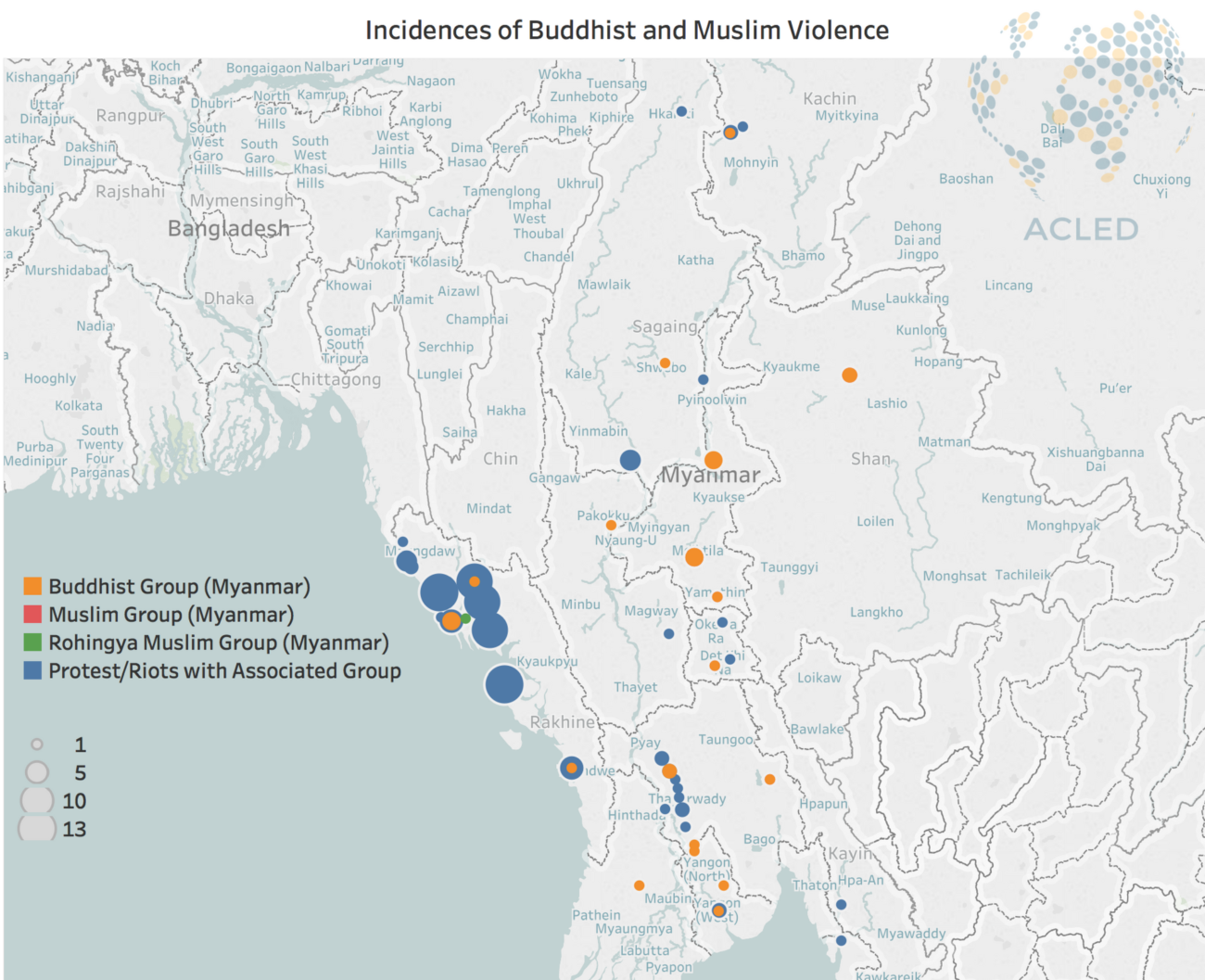Overview
Despite a ceasefire agreement in 2015[1], violence in Myanmar has increased as clashes between government and non-state groups[2] continues to grow in areas party to the ceasefire and those not (see Figures 1 and 2). The vast majority of conflict events engage the government, who remains responsible for the intensity and devastation of the various conflicts. Since an election which ushered the opposition into power (also in 2015), the state and military have taken extreme steps to consolidate power across the peripheral regions, using both discrimination and violence. The conflict in Northern Rakhine state has demonstrated the extent to which the government and military are willing to go to control and repress the state’s periphery.
Significant attention has been directed towards the conflict in Northern Rakhine state since 2016. where Three townships that were home to an estimated million Rohingya Muslims have largely emptied (more than 85% of the population (ICG 2018)), and the government has intentionally destroyed two thirds of all villages by the state (Amnesty International).
Figure 1: Myanmar Conflict Timeline
The potential for a sustained crisis in Rakhine state is likely, although not in the form of continued clashes. Even small actions by the militant ARSA (Arakan Rohingya Salvation Army) have a disproportionate response by the government, who appears to be planning for a future campaign of ‘open imprisonment’ of any Rohingya who return from neighbouring Bangladesh. This involves villagization campaigns, increased pro-government militias, and a campaign of anti-muslim actions.
Further, tensions between the government and several other armed groups operating in Myanmar have increased in recent years, suggesting the government is attempting to reconsolidate any power and control lost during two periods of peace agreements (2012 and 2015). In addition to ongoing contestation with geographically peripheral ‘ethnic’ groups, a violent form of ‘Buddhist nationalism’ is constraining the actions of political parties and the regime who serve the majority of Myanmese citizens (who do not politically identify as an ‘ethnic’ group member). In turn, this new cleavage (of radical Buddhist vs others) is a crucial indicator of multiple divisions in Myanmar. The political environment is fraught, characterized by a military who acts with impunity, a national political scene where the former opposition has lost much of its international and (potentially) domestic support, and a deepening crisis between ‘majority vs several minority groups’. The domestic situation is further enflamed by the resumption of large scale regional fighting on multiple fronts; valid claims of genocide and/or attempts to create a zone for the open imprisonment of the Rohingya in Rakhine state; and several ethnic based armed organizations that both ally and contradict each other’s geographic and operational space. Taken together, this does not suggest a positive, peaceful or negotiated outcome is likely for the current armed groups, their umbrella organizations, or the citizens of Myanmar’s periphery. Further, stabilization appears unlikely.
Timeline of Armed Group Activity Since 2015
Activity across Myanmar since 2012 is characterized by repeated campaigns of high battle activity by the state. Often these high battle periods are preceded by riots and protests (see Figure 1). However, the riots and protests becoming more common in Myanmar concern many issues, including public services, fair treatment under the law, elections, and increasingly, identity. The same periods that lead to high violence, including elections, the passing of new laws limiting the rights of others, attacks on various communities (increasingly on Muslim Myanmese), appear to fuel some battles and attacks on civilians, but certainly not all. A extremely high proportion of Myanmese violence (over 73% of all reported events) involved some branch of state forces, who therefore dominate the violent environment.
Figure 2: General Intensity Map of Myanmar Violent Events
Fighting sharply escalated in February 2015 when one faction of the former ceasefire group– the Myanmar Democratic Alliance Army– attacked the capital city of their former enclave, the border town of Laukkai. Levels of conflict escalated further in November 2016 with coordinated attacks by the Myanmar Democratic Alliance Army, the TNLA, the Arakan Army, and the Kachin Independence Army— formalized as North Alliance—in Muse (on the border with China), which resulted in more than a dozen deaths, thousands of refugees and IDPs and the suspension of border trade. By far, the most conflict is between the state and the groups within the Northern Alliance, and it is particularly high in Kachin and Shan State (see timeline 1).
Conflict Agents, Geography and Cleavages
The main cleavage creating violence in Myanmar has been the nature of the relationship between the national regime and its ‘ethnic’ peripheral communities. Through a campaign of violence and repression, the former military regime has attempted to subvert subnational identities, in favour of the majority. Over 135 ‘ethnicities’ are recognized in Myanmar, and the designation as an ‘ethnic’ group is one that confers some rights, albeit often ignored by the regime. In recent years, the difficulty of groups to access rights through an ethno-regional claim has created new politicalized identities, including an Islamist community. This, in turn, has been countered by a violent Buddhist nationalism[3] that is state condoned, if not supported.
Myanmar hosts dozens of violent non-state groups, some of which conduct extremely local attacks, others that are increasingly operating outside of their typical geographic ethnic space. Table 1 reviews the active groups and their characteristics, and Figure 3 highlights the most frequently active groups. The Asia foundation suggests that at least eleven of Myanmar’s fourteen states and regions experience latent or subnational conflict (over 118 of Myanmar’s 330 townships); these large areas make up approximately ¼ of the state’s population. In recent years, the conflicts have centred in Shan, Kachin and Rakhine states, whereas previously they had mainly been located in the South.
Table 1 details several details of each group with significant activity since 2015. (ACLED – Myanmar Conflict Update – Table 1)
Figure 3: Most Active Armed Groups
Despite the multiple of groups seeking recognition and some form of territorial autonomy, these non-state groups are often active in the same territories. This suggests that the geographical boundaries of the group are not in line with operational boundaries. Further, a multi-actor space creates a high likelihood of spoilers in any peace negotiations and competition for space and support within the non-state armed group community. Below is a review of extremely active states, as of 2015.
Kachin/Shan Violence: Most violence in Kachin and Shan states engages the Kachin Independence Organization–KIO. KIO is the KIA’s political wing and did not sign the government’s nationwide ceasefire agreement (NCA) in 2015. The KIA and government have fought since 2011 after a 17-year bilateral cease-fire agreement between the two sides broke down. Clashes between both have displaced about 100,000 people over the past six-plus years, and fatalities estimated in the hundreds. Intense fighting began in early 2017 when government soldiers launched air strikes in the gold and amber mining region of Tanaing. This was a direct assault on the resource stream for KIA (who levels a five-percent tax on mine operators). The KIA attacked regional military headquarters in Kachin since January 2017 and four civilians were killed between January 19 and 27. This activity continued in February 2017, when 50 KIA attacked army camps in Lwele village in Myitkyina district’s Moe Kaung township. The government appears to be handling the situations through blockading with food and water shortages and preventing those affected in fighting areas from leaving.
Figure 4: Kachin and Shan State Violence
KIA is a lead member of the Northern Alliance in which the Arakan Army (AA) and TNLA (Ta’ang National Liberation Army) are the other high activity members. These groups are also independently active: the Arakan Army (AA) currently operates in both Rakhine and Kachin state, having established itself initially outside Rakhine despite claiming the establishment of a self-governing Rakhine zone as the movement’s goal. The AA group is also against any Muslim and Rohingya activity in Rakhine state. In recent months, attacks between the state and the Arakan army have grown, possibly a reaction to the military occupation of Rakhine state by State forces. In November 2017, the government launched an offensive in Chin’s State Paletwa Township near the Myanmar-India border[4] against the AA. This is one of several large-scale assaults on the regional group.
Finally, the TNLA (Ta’ang National Liberation Army) is currently operating in Kachin and Shan States, and in addition to the KIA, are the most capable insurgents that the Myanmar government is currently engaging with. TNLA and KIA soldiers attacked government military headquarters in Kachin state government army base camps and the Lashio-Muse Highway, a main thoroughfare in northern Shan state. Fighting has continued between the national army and TNLA in Kyaukme, Namhsan, Namtu, and Kutkai townships, where the government is using more sophisticated, but less precise, hardware including helicopter attacks (TNLA forces in Shan state report over 50 past incidences)[5][6].
TNLA and the Restoration Council of Shan State (also known as the Shan State Army-South (a Nationwide Ceasefire Agreement signatory) clash over territorial infringement and control rights. The TNLA justify their expansion into SSA-S areas by claiming government troops and Pyithu Sit militias have engaged in extrajudicial executions, forced relocations and labor, and routine torture[7] while the SSA-S remains complicit through inaction. The military, TNLA and RCSS/SSA are regularly engaged in armed clashes in northern Shan State.
There are myriad of alliances that structure the interactions in Myanmar’s conflict environment. As demonstrated here, some critical alliance structures have recently formed: TNLA and KIA are members of the Federal Political Negotiation and Consultative Committee (FPNCC), which has called for a political dialogue with the government and for peace talks as a coalition rather than as individual members. The Northern alliance and the FPNCC/ Pangkham political alliance (which includes the United Wa State Army (UWSA), the Kachin Independence Army (KIA), the Shan State Progressive Party (SSPP), the TNLA, the Myanmar National Democratic Alliance Army (MNDAA), the Arakan Army (AA) and the National Democratic Alliance Army (NDAA)) attempt to negotiate contentious issues within the EAO communities, in order to reassert their combined strength. but as with many other non-state groups, despite their different agenda (and occasionally contesting agendas) they consider themselves better organized as a cohesive and coherent unit, rather than individual groups. Efforts to get United Wa State Party to be a coordinating leader of the northern groups is a significant development[8], and these umbrella organizations challenge the marginalization of nonsignatory EAOs who comprise 80 percent of all non-state armed groups.[9]
Indeed, the networks that define the current state of Myanmese conflict indicate that the non-state groups are cooperating in order to force the government from destroying individual groups. These alliances are also the site of infighting, which is why network alliance structures are volatile and spoilers are common. Figure 5 is a network map which shows both the current active alliances, their members and the intersection between each group’s spatial signature and their network. As noted in this network, there is little cohesion between regional, alliance or consortium non-state group members. Each group may see the benefit in temporary alliances, but those connections are fragile and subject to volatility.
Figure 5: Networks
Rakhine State
Since 2016, the conflict in Rakhine state has become the central focus of international attention. It represents a renewed conflict within Myanmar and a fault line that could do tremendous damage to the domestic and regional attempts at stability. The difference between previous conflicts in the region and the current violence is the role of Rohingya militants in challenging the state, and the government’s response to Rohingya civilians. Upwards of 85% of the Rohingya community are believed to have left Northern Rakhine state in the past 18 months. This exodus mirrors previous movements of Rohingya, although the magnitude is significantly larger now (as is the population). See Figure 6
Figure 6: Rakhine State Violence
According to interviews with survivors, violence has been worst in Min Gyi (Tula Toli), Chein Kar Li, Koe Tan Kauk and Chut Pyin. HRW also reported on the violence in Maung Nu village. Inn Din was also severely affected (and is where the mass grave has been reportedly found)[10].
Several key moments in the Rakhine conflict are outlined in the Timeline (Figure 7) below, including an increase in anti-Muslim violence in Northern Rakhine in 2012 (often by Buddhist militants); a cessation of rights and disenfranchisement leading up to the 2015 election; the establishment of the ARSA/HaY[11] group in 2013; and violent actions in 2016 through 2018 by ARSA and others. ARSA is the latest manifestation of Rakhine Muslim actions against an oppressive state, but it also represents an important break from the recent past. ARSA is prioritizing its Muslim identity, over the Rohingya identity and there are three possible reasons for this: 1) the Rohingya community has proven insufficient as a means through which to acquire ethnic rights in Myanmar; 2) Islam, over ethnicity, allows for greater support within and outside Rakhine state, while still assuring Rohingya support[12]; and 3) financing has been forthcoming for this ‘brand’ of conflict group. Several reports suggest that ARSA is well financed and supported by Saudi ties[13]. ARSA is believed to have been established in 2013, but its first attack (October 9th 2016) was carried out by 400 men with sticks, knives etc. Subsequent attacks displayed a much higher degree of sophistication (including the use of IEDs), and the overall actions suggest training in modern insurgency tactics; both which reinforce the impression of external funding.
Figure 7: Timeline of Rakhine State Activity
The government is claiming that actions by the ARSA are the reason for ongoing hostilities, property destruction, and blockades. However, no organization has evidence of any additional actions by ARSA since January 5th 2018 attack. An Amnesty International report suggests that, following violence in August-October 2017, the military may have justified their actions by claiming they were going after ARSA, but the attacks were carried out against whole Rohingya villages indiscriminately. However, the government claimed that this violence included ‘battles’ with ARSA, rather than violence against civilians. Human Rights Watch analyzed satellite imagery that suggests 55 villages were destroyed in Rakhine[14] through 2017. The government was likely responsible for due to the mode of destruction and the patterns. The AI report noted that after the initial massacres, the burning of villages was ongoing, but that in some cases villagers were warned that their village would be burned and were able to flee (thus, possibly meaning less fatalities for later events). Where villages have both Rakhine and Rohingya sections, the Rohingya section was targeted and the burning was controlled (indicating it is unlikely that locals were doing the burning).
On average, 75 Rohingya fled their villages each day between Jan. 1 and Feb. 15th of 2018, indicting some level of repression and ongoing violence.[15] This “ongoing flight seems at odds with the refugee repatriation process that Myanmar and Bangladesh authorities had agreed would begin on Jan. 23. As of Feb. 15, not a single refugee has been returned to their Myanmar homes.”[16]
News reports indicate that the government was actively trying to prevent Rohingya leaving, in order to complete the destruction of the communities (as part of the Four cuts strategy whereby the government denies rebels and supports of food, fuel, intelligence and recruits[17]). Further, Amnesty International reports that since late 2017, the government is constructing several bases in the area. These bases will be coordinating locations for population control and possibly future insecurity. In addition, ‘repatriation’ centres appear to be part of a villagization campaign of population control; a news report in December suggested that, in addition to burning existing villages, erecting new ‘population centres’, military bases and roads, the government is encouraging non-Muslim Rakhine villagers to move into the Northern townships[18]. The government has also encouraged the formation of local militias, similar to those operating in the East of the state, as an indirect control mechanism and pro-government local forces.
The government is also accused of arming of local communities as Border Guards as a way to police and ‘cleanse’ the Rakhine region. This mirrors the activity and groups in the Eastern part of the state (e.g. Shan state). Attacks on many villages within Buthidaung and Rathedaung townships (Sittwe district) in late August and early September involved the military, BGP and, in some cases, local vigilantes killing civilians, raping women and burning down the villages. Landmines were also planted on the border with Bangladesh in the path where Rohingya were fleeing. Villagers and plain-clothes soldiers patrol sites where signs warn of a “Forbidden Area” without Muslim inhabitants[19].
New Cleavages
When considering the conflict environment in Myanmar there are many intersecting issues at play that make a government based intervention important, but limited in effect. These include a new cleavage that has emerged which could further destabilize the state. Anti-muslim violence has increased as Buddhist radicalism/nationalism has risen as an ideology amongst the majority population. The Buddhist radical movement has some support amongst government ministries and parties, as well as the public. In turn, this has deepened the support of anti-muslim practices, observed in urban areas and rural areas (with special reference to Rakhine state in 2012). While the 969 movement has seized on the Rakhine issue pointing to the anti-Muslim narratives, anti-Muslim urban violence is quite different than anti-Rohingya violence in Rakhine state (albeit overlapping, as Muslims are identifying themselves as Rohingya in solidarity in greater numbers).
Figure 8: Buddhist and Muslim Violence
Special Focus: Data on Myanmar
Data concerns in Myanmar involve:
Coverage– access to high violence areas, and in particular northern Rakhine state, has been limited over the duration of the conflict in 2016. Several journalists have been arrested and charged under the state’s information act (or the 1908 Unlawful Associations Act) when attempting to report on mass graves, others when witnessing drug burning (a critical source of income for local government and affiliates); some journalists have been fired or report a high degree of self-censorship on the details of conflicts.
International organizations often need to rely on after-the-event reporting from affected parties, rather than reporting in situ and in real time. As a result, single witnesses and inconsistent reports are common. This results if an under-reporting of conflicts where IDPs, rather than cross border movements, are common. In contexts where civilians have been attacked by local militias and/or government troops, few survivors are likely to relay the information about the location, extent and perpetrators of the attack. Often, improved information on events is available after the fact.
Bias– the reporting for many peripheral ethnic conflict, and those with a religious dimension- such as the Rakhine conflict- are subject to a large degree of biased reporting from the main media serving the Myanmese majority. Increases in anti-Muslim rhetoric since 2011 has fuelled harsh commentary on the Rakhine conflict, from both the government and public.
Misinformation– the actions of the Myanmese government have come under significant question in the duration of the Rakhine conflict in particular, but can be extended to other violent contexts across the state. On several occasions- including the assertion that ARSA militants and Rohingya communities purposefully destroyed their homes and villages, and that large scale continued assaults in the Rakhine area are due to ongoing (but unreported ARSA actions), the governments campaign of misinformation has been evident.
–
[1] During which 8 significantly active groups signed, including ABSDF, Arakan Liberation Party, Chin National Front, DBKA-5, the Karen National Union (KNU), the KNLA Peace Council; the Pa-O National Liberation Army and the Restoration Council of Shan State (SSN)
[2] Both signatories and non-signatories of the peace agreement
[3] ICG report: https://www.crisisgroup.org/asia/south-east-asia/myanmar/290-buddhism-and-state-power-myanmar
[4] https://www.irrawaddy.com/news/burma/aa-myanmar-army-clashes-likely-intensify-arakan-army-spokesman.html
[5] https://www.rfa.org/english/news/myanmar/clashes-between-myanmar-army-and-ethnic-militias-ensue-in-kachin-shan-states-02052018165131.html
[6] 135 ethnic groups are recognized, but discussions are under way to expand this list to reflect the population census conducted in 2014
[7] IPIS, 2017
[8] Burma’s Northern Shan State and Prospects for Peace. David Scott Mathieson. Sept 29, 2017.
[9] FPNCC/ Northern Alliance: Arakan Army (AA), Kachin Independence Army (KIA), Myanmar National Democratic Alliance Army (MNDAA), TNLA, SSPP/Shan State Army-North (SSA-N), Shan State East National Democratic Alliance Association (NDAA); United Wa State Army (UWSA)
NCA Signatories: Karen National Union, Democratic Karen Benevolent Army, KNU/KNLA Peace Council, Restoration Council of Shan State (SSA-S), Pa-Oh National Liberation Organisation, Chin National Front, Arakan Liberation Party, All Burma Students’ Democratic Front, New Mon State Party (NMSP/MNLA); Lahu Democratic Union (LDU). Note: NCA signatories are not necessarily allies.
UNFC: Karenni National Progressive Party (KNPP-Karenni Army); Arakan National Council (ANC)
[10] Amnesty International 2017. In addition: In southern Maunder (Inn Din) during December, a mass grave containing the remains of ten murdered Muslims was found, and Muslim villages along the side of the Ah Ngu Maw-Maungdaw highway had been destroyed.
[11] Harakah al-Yaqin was used by ARSA in the past, they do not use this name anymore it seems.
[12] Regional and foreign support for the Rohingya through its Muslim identity is gaining traction in Bangladesh (https://www.crisisgroup.org/asia/south-east-asia/myanmar/myanmarbangladesh-humanitarian-calamity-and-two-country-crisis), where an Islamist movement (Hefazat e Islam) has support from the (typically secular) Al Awami regime (https://www.crisisgroup.org/asia/south-east-asia/myanmar/myanmarbangladesh-humanitarian-calamity-and-two-country-crisis). The pressures of the Rohingya struggle on Bangladesh could lead to the forced return of the displaced prematurely, exacerbating the conflict, owing to potential support from sympathetic regional parties. Several pieces on militancy in Bangladesh could serve as useful notes on this crisis: Electoral violence in Bangladesh (another election is expected at the end of this year); Isis in Bangladesh and Bipartisanism and violence
[13] ICG – A New Muslim Insurgency
[14] http://www.dvb.no/news/bulldozing-rohingya-villages-not-demolition-evidence-burmese-official-says/79904
[15] https://www.irrawaddy.com/news/burma/myanmar-receives-list-returnees-bangladesh.html
[16] https://www.irrawaddy.com/news/burma/analysis-rohingya-still-fleeing-rakhine.html
[17] As noted in https://www.crisisgroup.org/asia/south-east-asia/myanmar/283-myanmar-new-muslim-insurgency-rakhine-state
[18]https://www.irrawaddy.com/news/burma/settling-scores-northern-rakhine.html
[19] https://www.irrawaddy.com/news/burma/analysis-rohingya-still-fleeing-rakhine.html

